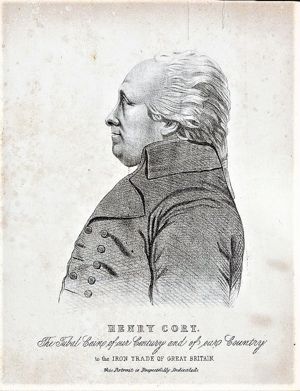Biography
Henry Cort was born about 1740 in Lancaster of unknown parentage [1]and made his way to London. He married Elizabeth Brown at Crowhurst in Surrey on 21 April 1764. [2] By 1765 he was profitably established in Surrey Street, Strand, London in business as a navy agent. [3]
In 1768 at St Thomas the Apostle in London he married Elizabeth Haysham [4] from Gosport in Hampshire. He had become interested in iron learning that English iron was considered too poor to be used to supply the government. Elizabeth’s uncle, William Attwick, had an iron business in Gosport. By 1777 when his fourth son was born he and his family were living in Elizabeth’s home town and Henry was working with uncle William in his business in Middle Street. It was about this time that Henry went into partnership with Samuel Jellicoe, son of the wealthy Deputy-Paymaster of seamen’s wages, Adam Jellicoe. Funded by Adam Jellicoe they bought a wharf in Gosport and erected a forge and an iron mill at Fontley near Fareham at the north of Portsmouth Harbour. Henry improved on the processes that had been in use and business flourished. Patents were taken out in 1783 and 1784. By 1786 Lord Sheffield was lauding Cort’s achievements, and other ironmasters were seeking to use his patents.
Adam Jellicoe died in August 1789 and it was discovered that there was a serious deficit in his accounts as he had been funding Henry and Samuel with public money. The Government was unable to obtain the money from Jellicoe’s estate but the debts were secured on the partnership of his son and Henry Cort. Henry’s patents were taken by the Government but the enterprise at Fontley was put into Samuel Jellicoe’s hands. Henry was ruined. [3] He retreated to London with his wife and twelve children.
In 1794 Henry was granted a Government pension of £200 per annum. He died in his lodgings in Devonshire St in London on 23 May 1800 [1] and was buried in st John Hampstead churchyard. [5] Though Henry died in comparative poverty, he laid the foundations for many gigantic fortunes.
Cort & Iron: He developed a method of making iron bars with grooved rollers which he patented in 1783.
In 1784 he patented a puddling process in which the carbon in the iron was separated by stirring molten pig iron in a reverberating furnace. The action of the air in the decarburization causes pure iron to form. After the slag was removed, the molten iron was then applied to Cort's grooved rollers.
Both inventions were only improvements over the existing but his original contribution was from the combination of the two processes, which made iron more readily available throughout Britain and quadrupled production in 20 years.
Dr Jenny Bulstrode, a lecturer in history of science and technology at University College London (UCL), has undertaken an analysis of correspondence, shipping records and contemporary newspaper reports which reveal the innovation in the wrought iron process was first developed by 76 black Jamaican metallurgists at an ironworks near Morant Bay, Jamaica. Many of these metalworkers were enslaved people trafficked from west and central Africa, which had thriving iron-working industries at the time. The machinery from the ironworks was acquired by Cort and shipped to Portsmouth, where he patented the innovation. [6][7]
Sources
- ↑ 1.0 1.1 Oxford dictionary of National Biography: Cort, Henry (1741?–1800)
- ↑ Marriage record St George, Crowhurst (Henry Court gentleman of this parish married Mrs Elizabeth Brown of St Giles in the Fields in the county of Middlesex in this church by license this twenty fourth of April 1764)
- ↑ 3.0 3.1 Henry Cort by Samuel Smiles
- ↑ England, Select Marriages, 1538–1973 FHL Film Number 375022, 942 B4HA V. 6 (St Thomas the Apostle, London 17 March 1760 Henry Cort married Elizabeth Haysham) Viewed at Ancestry. Transcription only. Thought to be a transcription error for 1768.
- ↑ Burial record St John at Hampstead Churchyard, London (29 May 1800 Henry Cort born 1840) Viewed at Ancestry. Text only
- ↑ Black metallurgists and the making of the industrial revolution https://www.tandfonline.com/doi/full/10.1080/07341512.2023.2220991
- ↑ Industrial Revolution iron method ‘was taken from Jamaica by Briton’ https://www.theguardian.com/science/2023/jul/05/industrial-revolution-iron-method-taken-from-jamaica-briton
See also
- Grace's Guide to British Industrial History [1]
* Wikipedia [2]
- www.cort.net
- http://www.madehow.com/inventorbios/88/Henry-Cort.html
- https://www.britannica.com/biography/Henry-Cort
- https://www.chemeurope.com/en/encyclopedia/Henry_Cort.html
- https://www.encyclopedia.com/people/science-and-technology/metallurgy-and-mining-biographies/henry-cort
- https://portsmouthdockyard.org.uk/timeline/details/1740-henry-cort
- Hannah Devlin, "Industrial Revolution iron method ‘was taken from Jamaica by Briton’" in The Guardian, 5 July 2023
No known carriers of Henry's DNA have taken a DNA test.
Have you taken a DNA test? If so, login to add it. If not, see our friends at Ancestry DNA.
 Mindy Silva
Mindy Silva
Henry is 23 degrees from Emeril Lagasse, 19 degrees from Nigella Lawson, 21 degrees from Maggie Beer, 42 degrees from Mary Hunnings, 28 degrees from Joop Braakhekke, 27 degrees from Michael Chow, 23 degrees from Ree Drummond, 26 degrees from Paul Hollywood, 24 degrees from Matty Matheson, 25 degrees from Martha Stewart, 33 degrees from Danny Trejo and 31 degrees from Molly Yeh on our single family tree. Login to find your connection.



